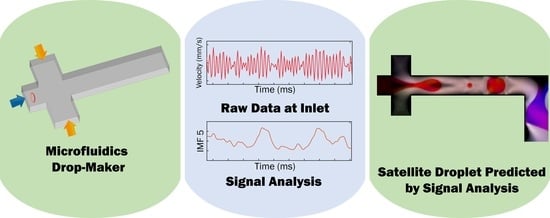Quantifying Uniform Droplet Formation in Microfluidics Using Variational Mode Decomposition
Abstract
:1. Introduction
2. Materials and Methods
2.1. Droplet Simulation
2.2. Signal Decomposition
3. Results
4. Discussion
Supplementary Materials
Author Contributions
Funding
Data Availability Statement
Acknowledgments
Conflicts of Interest
Abbreviations
| EMD | Emprirical Mode Decomposition |
| VMD | Variational Mode Decomposition |
| IMF | Intrinsic Mode Functions |
Appendix A. Variational Mode Decomposition
References
- Chang, C.B.; Wilking, J.N.; Kim, S.H.; Shum, H.C.; Weitz, D.A. Monodisperse Emulsion Drop Microenvironments for Bacterial Biofilm Growth. Small 2015, 11, 3954–3961. [Google Scholar] [CrossRef] [PubMed]
- Rotem, A.; Ram, O.; Shoresh, N.; Sperling, R.A.; Schnall-Levin, M.; Zhang, H.; Basu, A.; Bernstein, B.E.; Weitz, D.A. High-throughput single-cell labeling (Hi-SCL) for RNA-Seq using drop-based microfluidics. PLoS ONE 2015, 10, e0116328. [Google Scholar] [CrossRef] [PubMed] [Green Version]
- Shieh, H.; Saadatmand, M.; Eskandari, M.; Bastani, D. Microfluidic on-chip production of microgels using combined geometries. Sci. Rep. 2021, 11, 1565. [Google Scholar] [CrossRef] [PubMed]
- Takao, H.; Ishida, M. Microfluidic integrated circuits for signal processing using analogous relationship between pneumatic microvalve and MOSFET. J. Microelectromech. Syst. 2003, 12, 497–505. [Google Scholar] [CrossRef]
- Hébert, M.; Huissoon, J.; Ren, C.L. A perspective of active microfluidic platforms as an enabling tool for applications in other fields. J. Micromech. Microeng. 2022, 32, 043001. [Google Scholar] [CrossRef]
- Stone, H.; Stroock, A.; Ajdari, A. Engineering Flows in Small Devices: Microfluidics Toward a Lab-on-a-Chip. Annu. Rev. Fluid Mech. 2004, 36, 381–411. [Google Scholar] [CrossRef] [Green Version]
- Utada, A.S.; Fernandez-Nieves, A.; Stone, H.A.; Weitz, D.A. Dripping to jetting transitions in coflowing liquid streams. Phys. Rev. Lett. 2007, 99, 094502. [Google Scholar] [CrossRef]
- Lu, H.; Mutafopulos, K.; Heyman, J.A.; Spink, P.; Shen, L.; Wang, C.; Franke, T.; Weitz, D.A. Rapid additive-free bacteria lysis using traveling surface acoustic waves in microfluidic channels. Lab Chip 2019, 19, 4064–4070. [Google Scholar] [CrossRef]
- Mazutis, L.; Gilbert, J.; Ung, W.L.; Weitz, D.A.; Griffiths, A.D.; Heyman, J.A. Single-cell analysis and sorting using droplet-based microfluidics. Nat. Protoc. 2013, 8, 870–891. [Google Scholar] [CrossRef]
- Delley, C.L.; Abate, A.R. Microfluidic particle zipper enables controlled loading of droplets with distinct particle types. Lab Chip 2020, 20, 2465–2472. [Google Scholar] [CrossRef]
- Polenz, I.; Weitz, D.A.; Baret, J.C. Polyurea microcapsules in microfluidics: Surfactant control of soft membranes. Langmuir 2015, 31, 1127–1134. [Google Scholar] [CrossRef] [PubMed]
- Rivet, C.; Lee, H.; Hirsch, A.; Hamilton, S.; Lu, H. Microfluidics for medical diagnostics and biosensors. Chem. Eng. Sci. 2011, 66, 1490–1507. [Google Scholar] [CrossRef]
- Link, D.R.; Anna, S.L.; Weitz, D.A.; Stone, H.A. Geometrically Mediated Breakup of Drops in Microfluidic Devices. Phys. Rev. Lett. 2004, 92, 054503. [Google Scholar] [CrossRef] [PubMed] [Green Version]
- Zeng, W.; Jacobi, I.; Li, S.; Stone, H.A. Variation in polydispersity in pump- and pressure-driven micro-droplet generators. J. Micromech. Microeng. 2015, 25, 115015. [Google Scholar] [CrossRef]
- Chen, L.; Yang, C.; Xiao, Y.; Yan, X.; Hu, L.; Eggersdorfer, M.; Chen, D.; Weitz, D.A.; Ye, F. Millifluidics, microfluidics, and nanofluidics: Manipulating fluids at varying length scales. Mater. Today Nano 2021, 16, 100136. [Google Scholar] [CrossRef]
- Mutafopulos, K.; Spink, P.; Lofstrom, C.D.; Lu, P.J.; Lu, H.; Sharpe, J.C.; Franke, T.; Weitz, D.A. Traveling surface acoustic wave (TSAW) microfluidic fluorescence activated cell sorter (μFACS). Lab Chip 2019, 19, 2435–2443. [Google Scholar] [CrossRef]
- Caen, O.; Schütz, S.; Jammalamadaka, M.S.; Vrignon, J.; Nizard, P.; Schneider, T.M.; Baret, J.C.; Taly, V. High-throughput multiplexed fluorescence-activated droplet sorting. Microsyst. Nanoeng. 2018, 4, 33. [Google Scholar] [CrossRef]
- Alim, K.; Parsa, S.; Weitz, D.A.; Brenner, M.P. Local Pore Size Correlations Determine Flow Distributions in Porous Media. Phys. Rev. Lett. 2017, 119, 144501. [Google Scholar] [CrossRef] [Green Version]
- Carroll, N.J.; Jensen, K.H.; Parsa, S.; Holbrook, N.M.; Weitz, D.A. Measurement of flow velocity and inference of liquid viscosity in a microfluidic channel by fluorescence photobleaching. Langmuir 2014, 30, 4868–4874. [Google Scholar] [CrossRef]
- Schmid, P.J. Dynamic mode decomposition of numerical and experimental data. J. Fluid Mech. 2010, 656, 5–28. [Google Scholar] [CrossRef] [Green Version]
- Huang, N.E.; Shen, Z.; Long, S.R.; Wu, M.C.; Shih, H.H.; Chyuan Yen, N.; Tung, C.C.; Liu, H.H. The empirical mode decomposition and the Hilbert spectrum for nonlinear and non-stationary time series analysis. Proc. R. Soc. A 1996, 454, 903–995. [Google Scholar] [CrossRef]
- Lee, Y.S.; Tsakirtzis, S.; Vakakis, A.F.; Bergman, L.A.; McFarland, D.M. Physics-based foundation for empirical mode decomposition. AIAA J. 2009, 47, 2938–2963. [Google Scholar] [CrossRef]
- Wu, Z.; Huang, N.E. Ensemble empirical mode decomposition: A noise-assisted data analysis method. Adv. Adapt. Data Anal. 2009, 1, 1–41. [Google Scholar] [CrossRef]
- Jánosi, I.M.; Müller, R. Empirical mode decomposition and correlation properties of long daily ozone records. Phys. Rev. E - Stat. Nonlinear Soft Matter Phys. 2005, 71, 056126. [Google Scholar] [CrossRef] [Green Version]
- Ansell, P.J.; Balajewicz, M.J. Separation of unsteady scales in a mixing layer using empirical mode decomposition. AIAA J. 2017, 55, 419–434. [Google Scholar] [CrossRef]
- Sadeghi, M.; Foucher, F.; Abed-Meraim, K.; Mounaïm-Rousselle, C. Bivariate 2D empirical mode decomposition for analyzing instantaneous turbulent velocity field in unsteady flows. Exp. Fluids 2019, 60, 131. [Google Scholar] [CrossRef]
- Wu, H.T.; Wu, H.K.; Wang, C.L.; Yang, Y.L.; Wu, W.H.; Tsai, T.H.; Chang, H.H. Modeling the pulse signal by wave-shape function and analyzing by synchrosqueezing transform. PLoS ONE 2016, 11, e0157135. [Google Scholar] [CrossRef]
- Foucher, F.; Ravier, P. Determination of turbulence properties by using empirical mode decomposition on periodic and random perturbed flows. Exp. Fluids 2010, 49, 379–390. [Google Scholar] [CrossRef]
- Dragomiretskiy, K.; Zosso, D. Variational Mode Decomposition. IEEE Trans. Signal Process. 2014, 62, 531–544. [Google Scholar] [CrossRef]
- Liu, W.; Cao, S.; Jin, Z.; Wang, Z.; Chen, Y. A novel hydrocarbon detection approach via high-resolution frequency-dependent AVO inversion based on variational mode decomposition. IEEE Trans. Geosci. Remote Sens. 2017, 56, 2007–2024. [Google Scholar] [CrossRef]
- Stallone, A.; Cicone, A.; Materassi, M. New insights and best practices for the successful use of Empirical Mode Decomposition, Iterative Filtering and derived algorithms. Sci. Rep. 2020, 10, 15161. [Google Scholar] [CrossRef]
- Eckert, M. The Dawn of Fluid Dynamics: A Discipline between Science and Technology; Wiley-VCH: Hoboken, NJ, USA, 2007. [Google Scholar] [CrossRef]
- Seo, Y.; Kim, S.; Singh, V.P. Machine learning models coupled with variational mode decomposition: A new approach for modeling daily rainfall-runoff. Atmosphere 2018, 9, 251. [Google Scholar] [CrossRef] [Green Version]
- Diao, X.; Jiang, J.; Shen, G.; Chi, Z.; Wang, Z.; Ni, L.; Mebarki, A.; Bian, H.; Hao, Y. An improved variational mode decomposition method based on particle swarm optimization for leak detection of liquid pipelines. Mech. Syst. Signal Process. 2020, 143, 106787. [Google Scholar] [CrossRef]
- Xue, Y.J.; Cao, J.X.; Wang, X.J.; Du, H.K. Reservoir permeability estimation from seismic amplitudes using variational mode decomposition. J. Pet. Sci. Eng. 2022, 208, 109293. [Google Scholar] [CrossRef]
- Tenorio-Barajas, A.; de la Luz Olvera-Amador, M.; Altuzar, V.; Ruiz-Ramos, R.; Palomino-Ovando, M.; Mendoza-Barrera, C. Microdroplet Formation in Microfluidic Channels by Multiphase Flow Simulation. In Proceedings of the Conference Proceedings IEEE: 2019 16th International Conference on Electrical Engineering, Computing Science and Automatic Control (CCE), Mexico City, Mexico, 11–13 September 2019. [Google Scholar]
- Zeiler, A.; Faltermeier, R.; Keck, I.R.; Tomé, A.M.; Puntonet, C.G.; Lang, E.W. Empirical mode decomposition—An introduction. In Proceedings of the International Joint Conference on Neural Networks, Barcelona, Spain, 18–23 July 2010. [Google Scholar] [CrossRef]
- Huang, N.E.; Wu, Z. A review on Hilbert-Huang transform: Method and its applications to geophysical studies. Rev. Geophys. 2008, 46, 2007RG000228. [Google Scholar] [CrossRef] [Green Version]
- Gonzalez, R.; Woods, R. Digital Image Processing; Prentice Hall: Hoboken, NJ, USA, 2002. [Google Scholar]

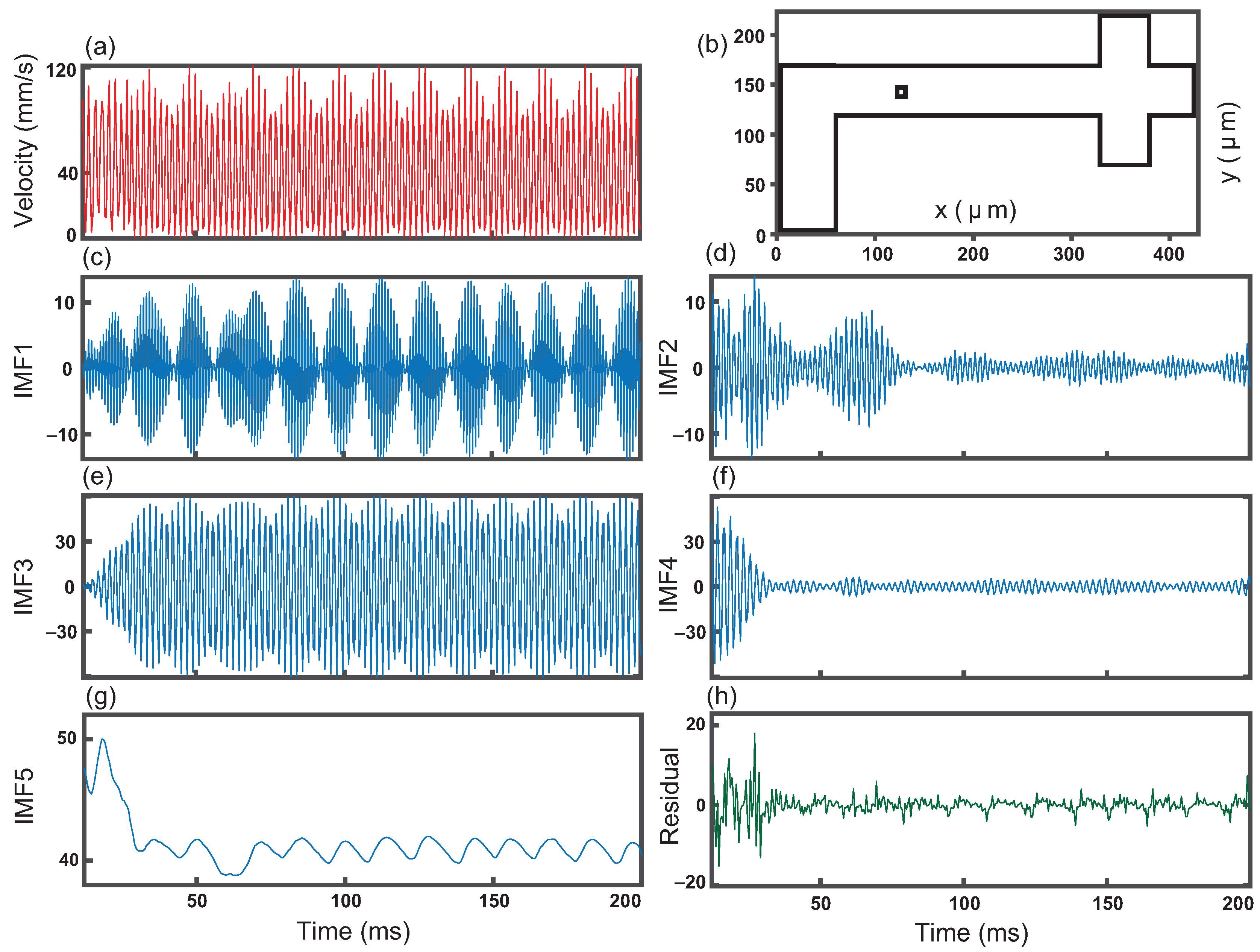
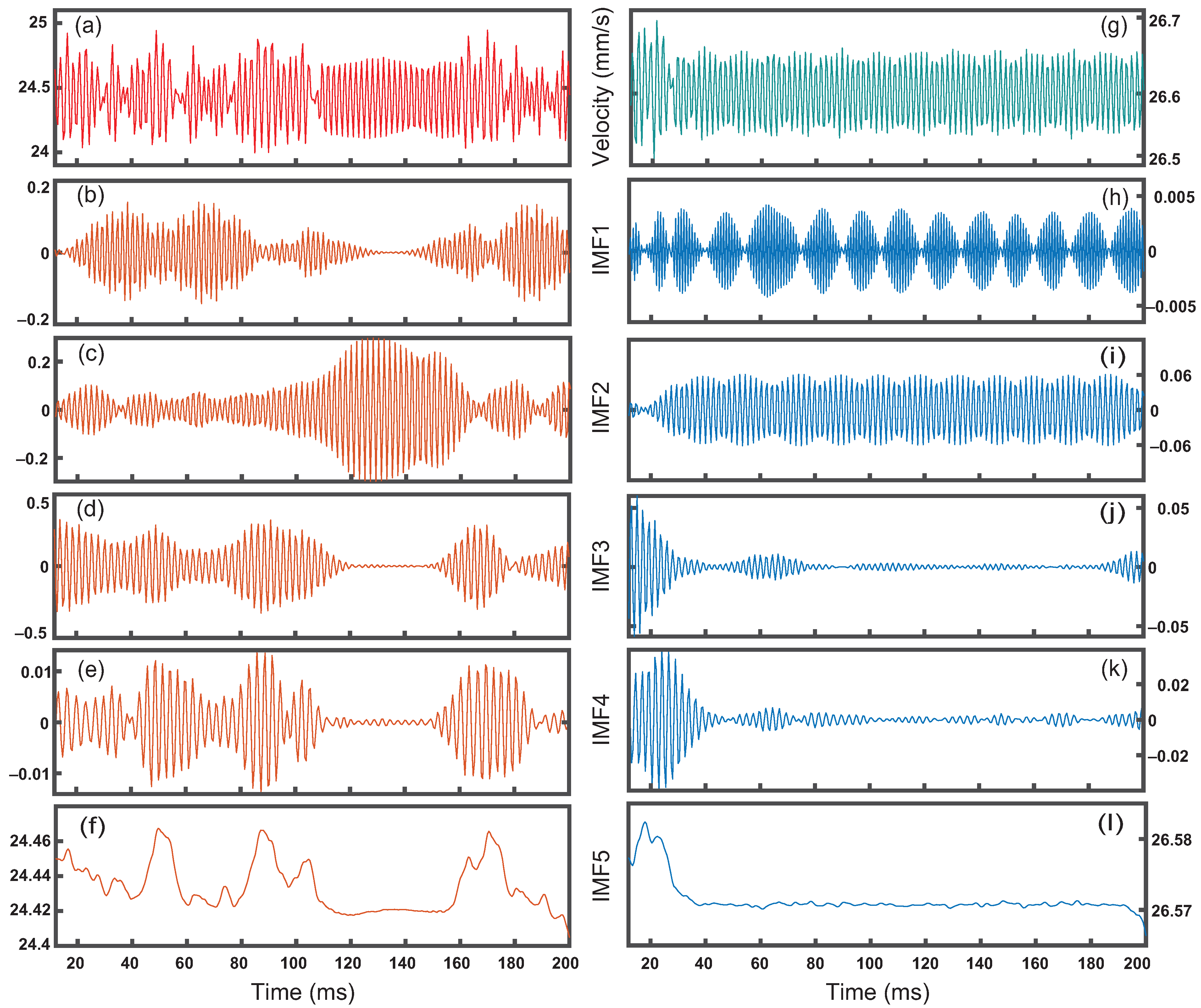
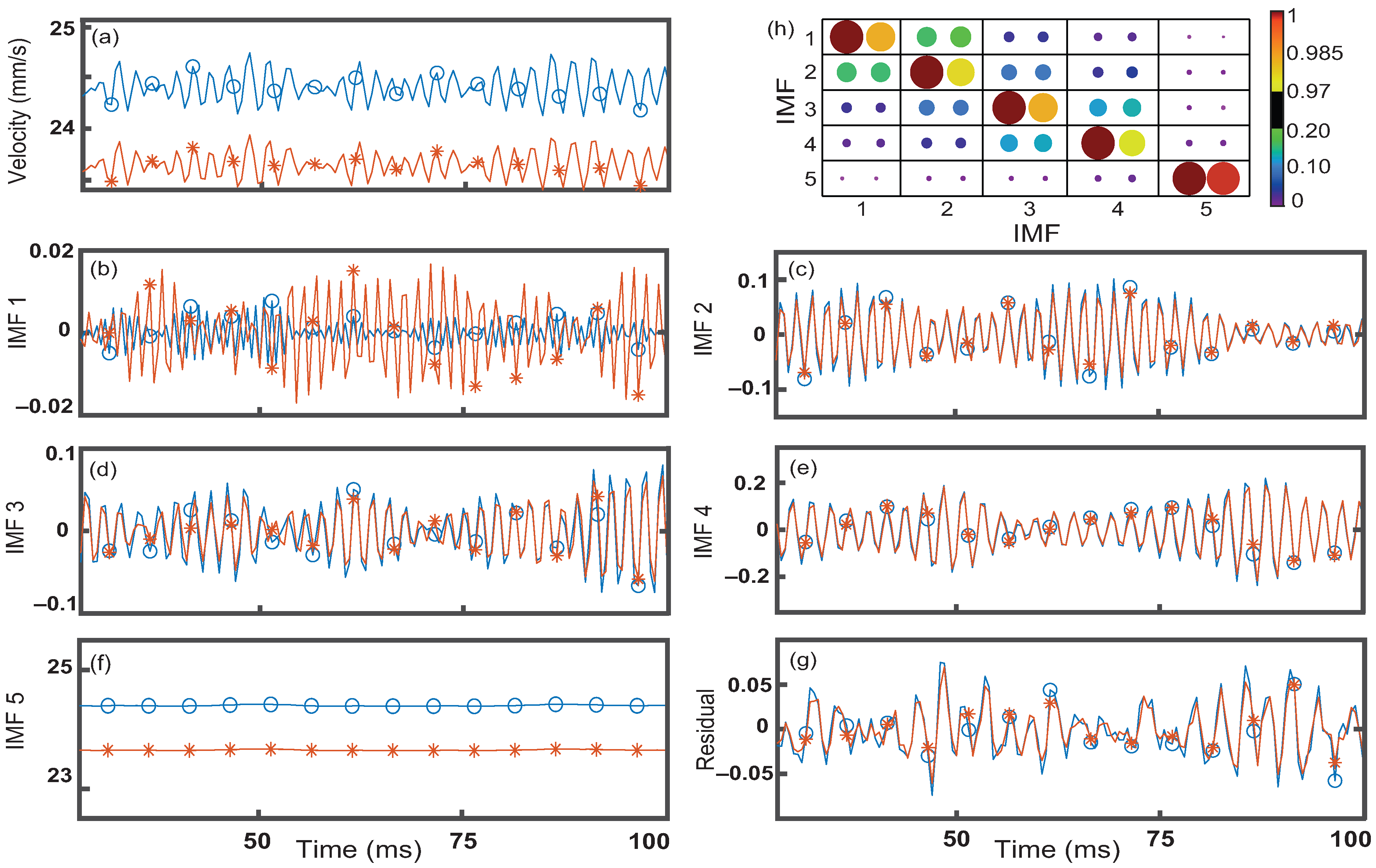
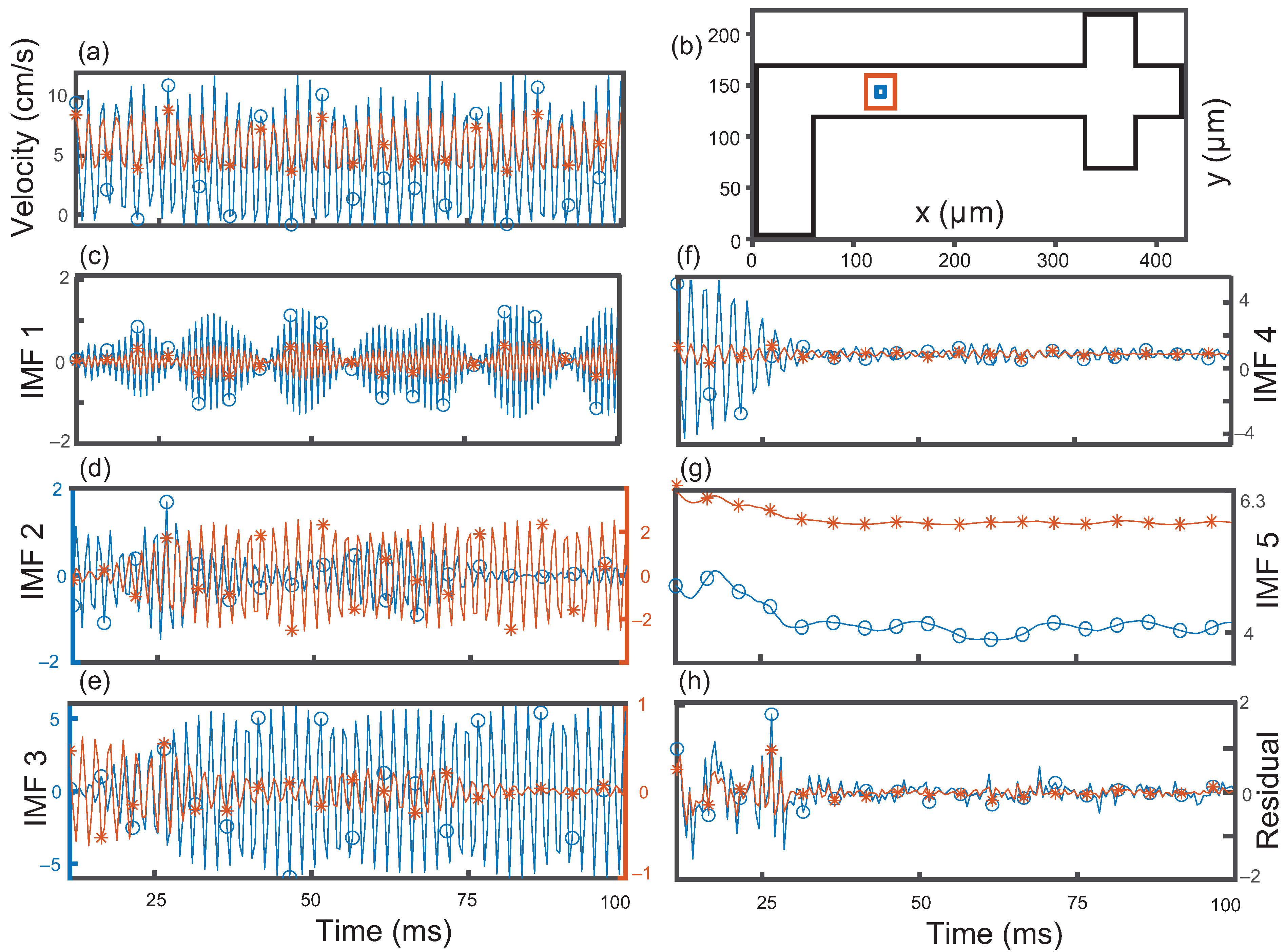
| IMF 1 | IMF 2 | IMF 3 | IMF 4 | IMF 5 | |
|---|---|---|---|---|---|
| IMF 1 | 1.0000 | 0.1003 | 0.0293 | 0.0239 | 0.0038 |
| IMF 2 | 0.1003 | 0.9999 | 0.0808 | 0.0447 | 0.0052 |
| IMF 3 | 0.0293 | 0.0805 | 0.9998 | 0.1500 | 0.0054 |
| IMF 4 | 0.0240 | 0.0446 | 0.1487 | 0.9997 | 0.0125 |
| IMF 5 | 0.0038 | 0.0052 | 0.0054 | 0.0124 | 1.0000 |
| IMF 1 | IMF 2 | IMF 3 | IMF 4 | IMF 5 | |
|---|---|---|---|---|---|
| IMF 1 | 0.9090 | 0.1622 | 0.0326 | 0.0240 | 0.0037 |
| IMF 2 | 0.1663 | 0.4976 | 0.3705 | 0.0486 | 0.0051 |
| IMF 3 | 0.0332 | 0.2301 | 0.5048 | 0.3761 | 0.0053 |
| IMF 4 | 0.0263 | 0.0518 | 0.2601 | 0.6468 | 0.0124 |
| IMF 5 | 0.0039 | 0.0061 | 0.0061 | 0.0093 | 0.9997 |
Publisher’s Note: MDPI stays neutral with regard to jurisdictional claims in published maps and institutional affiliations. |
© 2022 by the authors. Licensee MDPI, Basel, Switzerland. This article is an open access article distributed under the terms and conditions of the Creative Commons Attribution (CC BY) license (https://creativecommons.org/licenses/by/4.0/).
Share and Cite
Izaguirre, M.; Nearhood, L.; Parsa, S. Quantifying Uniform Droplet Formation in Microfluidics Using Variational Mode Decomposition. Fluids 2022, 7, 174. https://doi.org/10.3390/fluids7050174
Izaguirre M, Nearhood L, Parsa S. Quantifying Uniform Droplet Formation in Microfluidics Using Variational Mode Decomposition. Fluids. 2022; 7(5):174. https://doi.org/10.3390/fluids7050174
Chicago/Turabian StyleIzaguirre, Michael, Luke Nearhood, and Shima Parsa. 2022. "Quantifying Uniform Droplet Formation in Microfluidics Using Variational Mode Decomposition" Fluids 7, no. 5: 174. https://doi.org/10.3390/fluids7050174
APA StyleIzaguirre, M., Nearhood, L., & Parsa, S. (2022). Quantifying Uniform Droplet Formation in Microfluidics Using Variational Mode Decomposition. Fluids, 7(5), 174. https://doi.org/10.3390/fluids7050174





